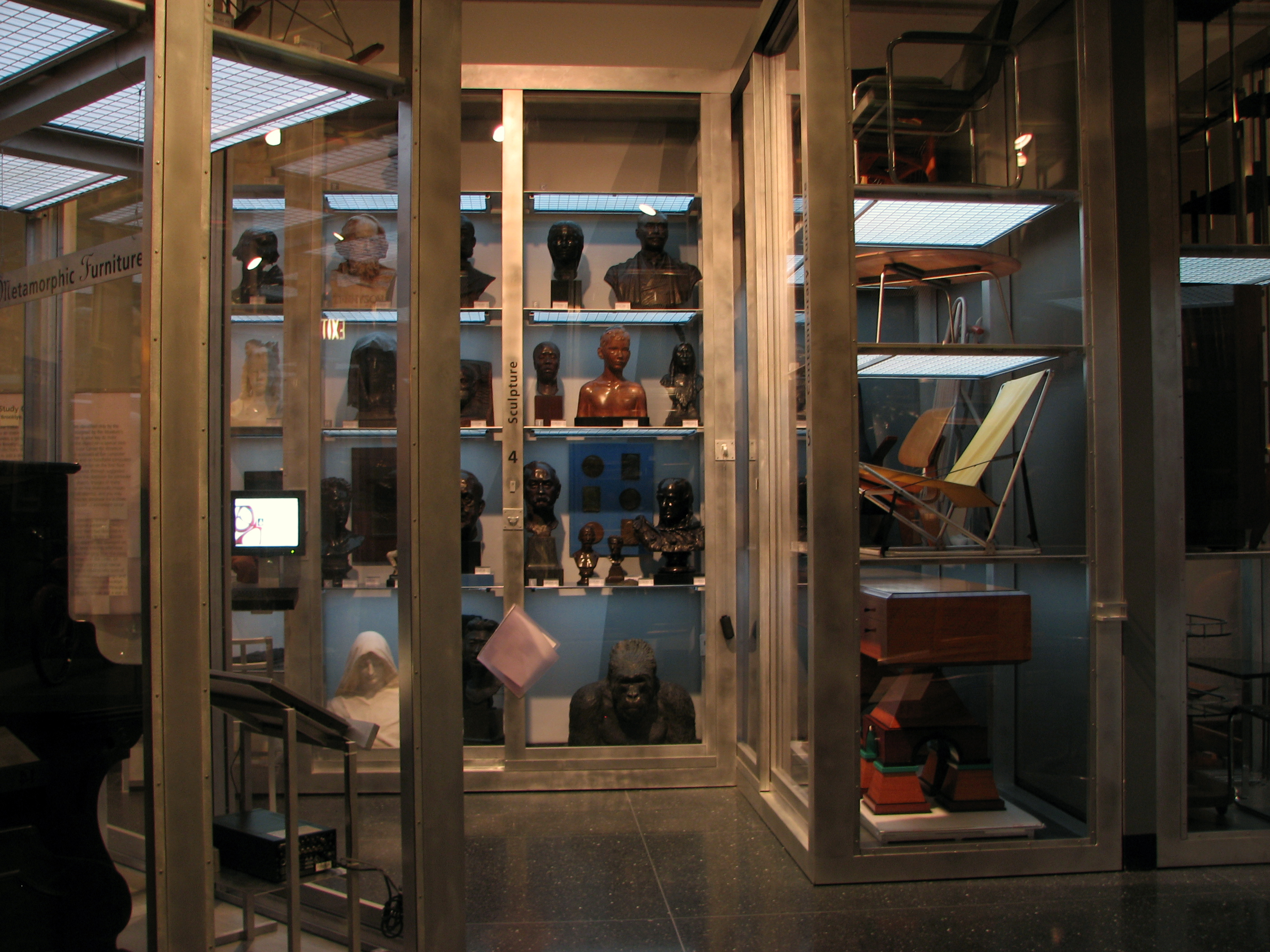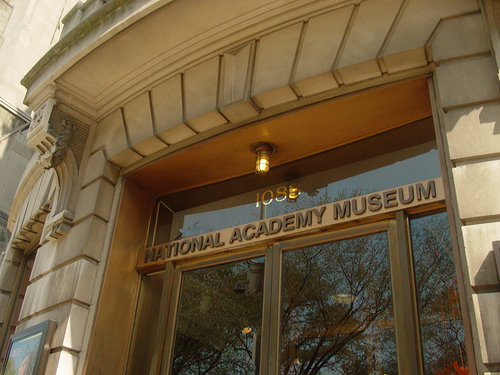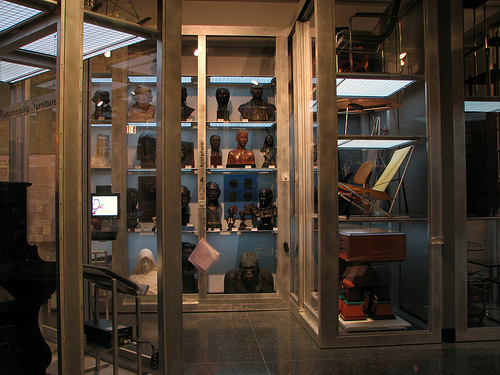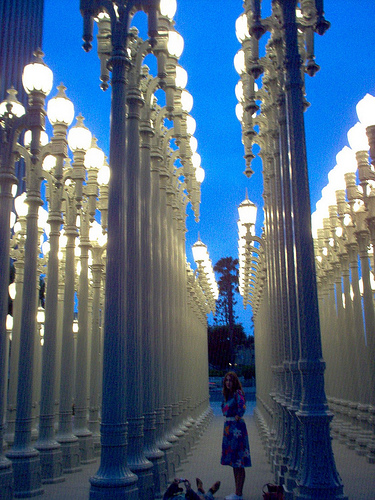
Visible Storage, Sculpture. Photo by Jenny Spadafora
One of eleven extant copies of the Bay Psalm Book, among the first books printed in British North America, will soon be up for sale. Experts estimate it will go for $10 to $20 million. Did a private book collector die or decide to prune their collection? No, this particular volume is being sold by the Old South Church, a congregation in Boston. Opponents of the decision have expressed concerns that the book would be sold to a private collector. This despite the fact that the Old South Church owns two copies of the book and is only selling one.
Controversies like the one over the sale of the Bay Psalm Book have become increasingly common since the mid-twentieth century. Many museums and other institutions that hold cultural objects no longer believe they must hold such objects in the public trust in perpetuity. Much of the museum community has agreed on best practices for deciding whether to give up an object, yet those practices, and specific museums’ adherence to them, are still hotly contested.
On one extreme, some critics feel deaccessioning, which refers to when an institution formally decides an item is no longer a part of its collection, is fundamentally in conflict with the idea that museum objects should be held in the public trust. On the other, a minority of museums consider deaccessioning to be a part of regular housekeeping, discarding items not only to correct past errors, but even taking in new items with the attitude that they may well be deaccessioned in a generation. Representatives of major institutions have voiced both ideas in the past decade. The more moderate pro-deaccessioning camp (most vocally Donn Zaretsky, a lawyer specializing in fine art) argues deaccessioning can be done without restrictions when it’s to save a museum from the threat of closing or other great danger.
The largest camp is made up of those who feel deaccessioning can be a part of healthy museum operations but only when following guidelines regarding who makes the decisions and how. The American Alliance of Museums advises, but does not require, that proceeds from deaccessions be used for future accession purchases only. The Association of Art Museum Directors considers this a hard and fast rule, and publicly and harshly censured the National Academy Museum, an institution that receives all of its collection by donation rather than purchase, for breaking it in 2008.
The casual museum-goer is unlikely to pay attention to whether each decision a museum makes is appropriate. However, many people inside and outside of the museum community share a belief that that museum objects should be accessible to the public, because museum objects are public objects, and museums are their caretakers. The values that underlie the interest in keeping museum objects public inform most discussions of deaccessioning, yet are rarely used as a metric to determine whether deaccessioning is appropriate. I propose a simple rule: the public should sit up and take notice when an institution is unwilling to take the steps necessary to ensure, or at least prioritize, keeping an object in public hands.
Whose Objects?
The word “deaccessioning” is not a household term. From the outrage over a large-scale deaccessioning project at the Metropolitan Museum of Art in 1972 to the outcry over Brandeis University’s plan to close the Rose Art Museum in early 2009, deaccessioning can seem like a non-issue until it becomes a huge issue. In the former, a New York Times article and other responses sparked concern that museum executives and curators were discarding art according to their own standards rather than relying on the wisdom of generations. In the latter, students who had never been to the Rose Art museum realized what they might be losing, and spread protest signs with the Rose logo and “ATM Inside” across campus. Alumni and donors argued that closing the art museum went against the university’s public service mission. I was a student at Brandeis at the time myself, and it was clear that the threat of losing this art, especially to private collectors, was inspiring high emotion.
These emotional discussions reveal two widely held values. First is the belief that certain cultural objects should be accessible to everyone. Second, museum property is public property; a museum is responsible for the longevity of artifacts but they belong to everyone. These values undergird oft-voiced concerns about the practice of deaccessioning, and each can be addressed by placing objects in other public-serving institutions’ care. If a museum deaccessions without respecting these values, it calls into question whether serving the public is truly the museum’s highest priority.
Cultural Property Should be Accessible to Everyone
A common defense of deaccessioning is that objects are not significantly more accessible in museums than they are in private hands. Most of a museum’s items just sit in storage gathering dust, the argument goes, and why does it matter if something unseen is sold? Elliot Bostwick Davis of the Boston Museum of Fine Arts told the New York Times that most American museums show between two and four percent of their collection at a time. The British Museum shows only one percent of its collection, while smaller museums in Britain frequently exhibit 5-10%. Moreover, not all museums are truly accessible to the whole public, because they fail to make accommodations for visitors with physical or financial limitations.
The logic that deaccessioning can be done freely because things aren’t accessible anyway is flimsy. Few private collectors are going to open up their homes to anyone and everyone who wants a close look at their stuff, but something that is unseen in a museum today may be on display tomorrow. For one thing, most museums rotate even their “permanent” exhibits. For another, methods of making more of the collection available have been slowly gaining popularity for decades. “Visible storage” is a system where objects that are not part of curated displays are stored in cases in rooms that are open to the public. Museums that have visible or “open” storage often have 15, 50, even 80 percent of their collection on display at one time.
Responsible transfers from one museum to another can improve accessibility by taking an item out of storage and putting them back on view to the public. It’s meaningfully different than when a museum sells to a private collector, and proponents of uninhibited deaccessioning are often incorrect when they argue that the items sold by one museum would not be of interest to another museum. For example, the director of the Irvine Museum in California told the LA Times she was “stunned” when another museum sold several important Impressionist works in secret to a private collector. The Irvine was one of several museums that said they would have been interested in the paintings had they been offered the chance to buy them. In this case, a transfer or inter-museum sale would have given the public another opportunity to enjoy these works.
Responsible transfers can also improve physical accessibility: if your historic house museum owns a collection of nineteenth-century leg braces, but can only display them in a room that’s up two narrow flights of stairs, perhaps they could be given to an institution with elevators so that twenty-first century museum visitors who wear leg braces themselves can see them. In the article “Guilt-Free Deaccessioning” (published in A Deaccession Reader, edited by Steven Weil, 1997), Steven H. Miller gives several examples of large general museums donating to small specialized or regional museums, an arrangement that improved the opportunities for the public to view those items.
People believe museum objects should stay accessible to everyone. Because this value is so widely held, it is important for any institution that holds cultural objects to make authentic accessibility a priority and to consider accessibility when planning for deaccessioning and disposal. Deaccessioning can be a great tool to improve accessibility, but if this value isn’t being taken into account at all, that is cause for concern.
Museum Property is Public Property
The loudest voices calling for cultural objects to stay in public hands are firm in their belief in museums’ responsibility to be a public repository for objects. In response to a 2005 Soethby’s sale of 42 impressionist paintings recently deaccessioned by the Los Angeles County Museum of Art, culture journalist Lee Rosenbaum wrote, “These sales are the latest sign that we can no longer depend on our cultural institutions to protect and preserve the public patrimony.”
Rosenbaum, who blogs as CultureGrrl at ArtsJournal, argues for very stringent decision-making processes on the part of museums who might choose to deaccession. In the same opinion piece, she calls for government action “when museums cross too many lines.” She also writes, “Museums’ permanent collections belong to all of us. The public has, in most instances, paid for these works through the tax deductions given to private donors.” The idea that museum property is public because of tax deductions to donors is used frequently in American deaccessioning debates. It’s also a stretch, since the value of an item donated is generally much greater than the tax revenue forgone through deductions. However, even Rosenbaum does not condemn all deaccessioning, and in the same piece she advocates trades or transfers of objects to other museums rather than putting these objects up for sale.
It’s important to note that museums (and some libraries) are generally the best custodians of cultural objects from the standpoint of preservation. Museum staff and contractors have the specialized knowledge to care for a precious work of art or historical artifact over the long term. Museums benefit from economies of scale in that the investment they make in regulating their environment protects many objects. While private collectors have an incentive to keep their possessions in good condition for their own enjoyment and for resale value, they don’t necessarily have a reason or the means to ensure the object will be in good condition beyond their lifetime. Museums’ role in preserving the lifespan of cultural objects is one very good reason certain objects should stay in museums, but that does not mean objects can never change hands within the museum community.
In fact, one of the reasons many institutions deaccession objects is that they feel burdened by gifts of the past that take resources away from their mission in the present. Many museums, especially older ones, accepted any and all donations of objects in the first years they were open, and later, after developing a clearer mission and a collecting policy, find themselves with objects that just aren’t a good fit. Institutions such as churches and schools can be in the same predicament. The expenses associated with proper object care provide a strong incentive for museums to limit the size of their collection.
Donn Zaretsky takes issue with the idea that anything should be permanently considered public or museum-worthy. On The Art Law Blog, he argues that museums should be free to deaccession whenever it makes sense for them, without having to consider unspoken donor intent. He feels that the public benefits of deaccessioning, such as saving a museum from closure, are too often ignored. This side of the argument is why selling items to the highest bidder is a cause for concern, but not proof that the decision is being mishandled. Institutions strive never to be in the dire situations Zaretsky references. However, those that try to sell their deaccessioned objects for the highest possible price, ostensibly to care for the needs of the institution and prevent getting into dire straits, are making a values decision to seek money to serve their mission rather than address their public-serving mission directly. It’s a delicate balance.
Even if a gift was legally unrestricted and the donor has long since passed, though, some observers still place moral responsibilities on museums. Many opponents of the Bay Psalm Book’s sale point to the fact that the book was given to the church as a gift. One told WBUR that to sell donated objects “is to break faith with these donors from the past.” In his article “Selling Items from Museum Collections,” another selection from A Deaccession Reader, Steven H. Miller writes, “The giving and receiving of an item, or the money to purchase it, is an act of faith in and by a museum. When accepting such offers a museum is establishing a relationship which it should be bound to honor.” However, considering that gifts can be a burden as well, if institutions are proxies for the public, one good proxy should be as good as another.
How Can Cultural Objects Stay as Accessible as Possible?
Cultural institutions wishing to avoid letting their deaccessioned objects fall into private hands have many options. The American Alliance of Museums runs an online forum, the Collections Exchange Center,where its member museums can list objects they want to sell, trade, or donate to another museum. The National Park Service runs a similar service primarily for its own sites, although it does not list objects for sale. Some museums use regional networks for the same purpose, and informal networks can also be useful, especially to non-museum institutions looking to find a new home for an object.
There is plenty of precedent for museums to sell or donate objects to other museums. Trades may be less common, but they too have been done. For example, in 1982, the Museum of Modern Art in New York reunited the four paintings in Kandinsky’s Four Seasons suite by trading paintings by Picasso and Matisse for two Kandinskys owned by the Guggenheim. For special cases in which an institution still has a use for a work of art, but finds that it can reach wider audiences elsewhere, joint ownership can present a useful alternative. Last year, Fisk University in Tennessee sold a 50 percent share in its Alfred Stieglitz art collection to the Crystal Bridges Museum in Arkansas. The collection of 101 American Modernist paintings will now spend two years at the museum followed by two years at the university.
A somewhat hairier alternative is to give public institutions special privileges at an auction that’s open to all. In 1994, the New York State attorney general ordered a special set of rules for an upcoming Soethby’s auction of items deaccessioned by the New York Historical Society. Public-serving institutions watched the auction and, before it closed, were permitted to pre-empt any sales, paying the highest bid minus a discount. This option is tricky because it doesn’t guarantee a museum will be able to take the object, but it’s available for organizations seeking a compromise between profit and public.
The Big Picture
While the museum field has mostly agreed upon best practices around the decision to remove an object from a collection, controversies over big deaccessions still arise year after year, partly because many institutions take liberties with standard practices or ignore them altogether. The general public can’t – and doesn’t need to – concern themselves with every deaccession. These controversies are not always easy to follow, but the best litmus test is whether an institution makes a priority of keeping objects in public hands, reflecting the values that museum property should be accessible to all and preserved for the future because it is public property.
Undoubtedly, some institutions would be appalled at giving or trading a valuable object away, or selling it for less than market rate, as may be necessary to ensure that object’s continued public accessibility. Boards of directors and museum leaders oversee an organization’s financial sustainability, and may worry that failing to seek the best price runs counter to that obligation. However, they are also charged with upholding the mission of the organization. How many institutions have language in their mission statements about benefiting the public, serving the community, or promoting a greater appreciation of the topic the museum’s content reflects? All this can be served by making responsible efforts to keep objects in public hands.


